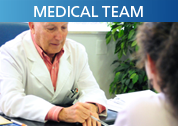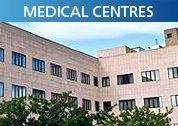
Specialized Centers
HOSPITAL CLÍNICA BENIDORM (HCB)
HOSPITAL CLÍNICO VISTAHERMOSA
HOSPITAL INTERNACIONAL MEDIMAR
Wrist and Trapezium-metacarpian Arthroscopy
Wrist arthroscopy is a minimally invasive technique that enables surgeons to diagnose and treat conditions affecting the soft parts of the joint.
Benefits of the Operation
As well as the typical benefits arthroscopy offers in comparison to open surgery, it also makes it possible to diagnose conditions that are difficult to pinpoint using conventional diagnostic methods. One particularly interesting application is arthroscopy of the trapezium-metacarpian joint, which permits early treatment of a degenerative condition that commonly affects this joint (rizarthorsis).
Medical-technical description
Between two and four 3 mm incisions are made around the damaged joint and a tiny camera and specific instruments for each type of injury are then inserted.
Injured wrist ligaments and the meniscus can be treated, as well as fractures, mini-resections of the trapezium with thermal treatment of the palmar ligaments in the early stages of rizarthorsis.
About the operation
Wrist and trapezium-metacarpian arthroscopy takes place in the operating theatre. An anaesthetist administers plexus anaesthesia (which anaesthetises the nerves going to the arm) and sedation, for a painless post-operative period.
This procedure can take between 30 and 60 minutes, according to the condition to treat. Patients usually spend a night in hospital and are able to go home the following day. On release, they are given a release report setting out the recommendations, treatment to follow and subsequent appointments.
Before the operation
- The patient goes to the doctor's office for a prior consultation, decisions are taken and the doctor explains the surgery in detail and gives the patient an informed consent.
- You will have pre-surgical tests consisting of a full blood test, biochemistry, coagulation, chest x-ray and ECG.
- You must wash the surgical site with antiseptic soap on the night before and on the morning of the surgery.
- You must not eat or drink for 8 hours before your operation.
- You must remove all metal objects during the operation (rings, bracelets, earrings, body piercings, etc).
Post-operative care
- For the first days after the surgery you may suffer some discomfort or swelling, which will disappear when you take the medicine prescribed by the surgeon.
- You will need to wear a compression bandage, which will be removed after 4 days, at which time you will be able to start moving the joint. In the case of a ligament repair, you may need block needles and a plaster cast, which will be removed after four weeks.
- Correct rehabilitation is necessary, so on the first few days you must not travel or do any strenuous or violent movements.
- You must keep the incisions dry until the stitches are removed between four and seven days after the surgery.
- After the stitches are removed you will be treated by a physiotherapist for between two and four weeks. You may need to wear a rigid wrist guard for part of the time during this period.
- You will normally be in a condition to drive and do some light activities once your physiotherapy starts. You can start doing sport again after 2 months.
The importance of immediate rehabilitation
- Correct rehabilitation is essential after an operation of this type. Rehabilitation should start as soon as possible and on the first few days you must not travel or do any strenuous or violent movements. That is why we recommend that before you go back to your country you should spend at least eight days doing rehabilitation at our Casaverde rehabilitation centre.
- This will help you to improve muscle tone and for the muscles affected by the surgery to gradually become stronger, which will reduce the risk of falling or complications.
- This will optimise mobility of the joint affected and reduce any pain and/or discomfort that may appear after the surgery.
- Improves trophism – nourishes the tissues around the operation site and encourages correct healing and closure of the surgical wound.
- Restores motor skills, giving patients help, guidance and re-educating them to adopt walking patterns that will soon have them on the road to recovery.



